Approach to Lip Roughness First Verification of Relationship Between Lip Balm Formulation Occlusivity and Lip Roughness Improvement
The Makeup Research Laboratories of Kao Corporation (President: Michitaka Sawada) recently reported that a highly occlusive lip balm formulation consisting of a combination of common oil and wax greatly contributed to improvement of lip roughness, with the results of that study presented in the International Journal of Cosmetic Science (42, 46-52, 2020).
Background
The lips are an area of the human body that can easily become dry and rough. Since there is no sebaceous gland at the boundary between the oral mucosa and skin, oil is not secreted to cover the surface. As a result, water evaporation is more likely to occur from the stratum corneum (SC) of the lips than from other skin types, and many people express concern about "dryness and chapping".
Lip balm is commonly used to care for lips and several studies regarding the effects of its components on improving lip roughness have been conducted. However, the contributions of the occlusivity of a coating film to lip roughness improvement remain unclear. Kao researchers conducted the present study to examine effects to improve the dryness and roughness of lips by different occlusive formulation samples comprised of a combination of common oil and wax.
Methods
Twenty Japanese female subjects with normal skin (age range 20-39 years; mean 28.1 years) who had concerns about their dry lips were enrolled. Two lip balm samples with different occlusive properties were prepared and tested. The subjects were divided into two groups so that SC capacitance and transepidermal water loss (TEWL) were very similar. Each applied one of the two lip balm samples 4 times a day (morning, noon, evening, before going to bed) for 4 consecutive weeks. Use of other lip cosmetics was prohibited throughout the test period. Visual, photography, 3D photography, and SC capacitance evaluations were performed at the baseline, and again after 2 and 4 weeks.
Visual evaluations were judged based on criteria for "roughness score" (Fig. 1) and "wrinkle score" (Fig. 2). In addition, using images obtained with a newly acquired ANTERA 3D camera, "hollow index" was quantitatively calculated using the wrinkle custom mode (Fig. 3).
-
* 1 The occlusivity of commercial lip balm preparations previously measured using a filter paper method adopted by Kao was shown to range from 60% to 90%. The low value and high value samples from that study were used.
-
* 2 The amount of water that evaporates from the body through the SC. A relationship has been shown indicating "the higher the number, the lower the barrier function of the SC".

Fig. 1. Lip roughness scores

Fig. 2. Lip wrinkle scores
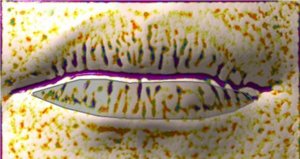
Fig. 3. Hollow index by ANTERA 3D
-
* Index of portion indented from surface (dark color) for entire lower lip.
Results
In the group that used lip balm with high occlusivity (highly occlusive formulation), the "roughness score" tended to improve after 2 and 4 weeks, while desquamation (chapping) was significantly reduced after 4 weeks (Fig. 4). In addition, "wrinkle score" and "hollow index" were also significantly improved after 4 weeks in the highly occlusive formulation group, with no deep vertical wrinkles or dents observed (Fig. 5, 6).
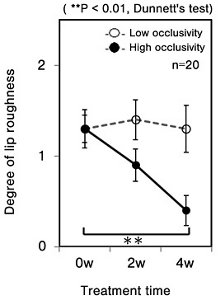
Fig. 4. Improved lip roughness
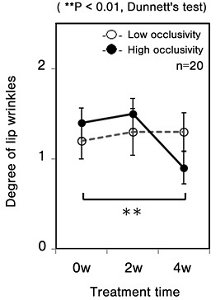
Fig. 5. Improved lip wrinkles
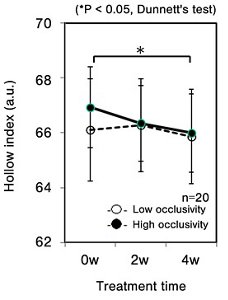
Fig. 6. Improved hollow index
Regarding the "SC capacitance" of the lips, found to be most correlated with range of roughness in previous studies, that was also significantly increased after both 2 and 4 weeks in the highly occlusive formulation group (Fig. 7). These results clearly showed that not only the appearance of the lips but also the condition of the SC were improved.
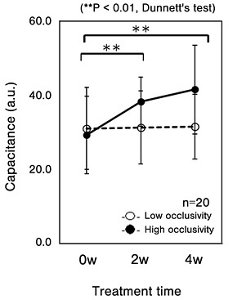
Fig. 7. Improved capacitance
Conclusion
Although lip balm is generally used for lip care, improvement effects based on its occlusivity characteristics have not been previously revealed. The present results clarified that the occlusive property of coating film has great effects to improve lip roughness. In the future, Kao will apply this knowledge to development of lip care formulations.
-
* Figures 4, 5, 6, and 7 are modified versions of those presented in an article originally posted in the International Journal of Cosmetic Science (42, 46-52, 2020).
About Kao
Kao creates high-value-added products that enrich the lives of consumers around the world. Through its portfolio of over 20 leading brands such as Attack, Bioré, Goldwell, Jergens, John Frieda, Kanebo, Laurier, Merries and Molton Brown, Kao is part of the everyday lives of people in Asia, Oceania, North America and Europe. Combined with its chemical division, which contributes to a wide range of industries, Kao generates about 1,500 billion yen in annual sales. Kao employs about 33,000 people worldwide and has 130 years of history in innovation. Please visit the Kao Group website for updated information.
Media inquiries should be directed to:
Corporate Communications
Kao Corporation
